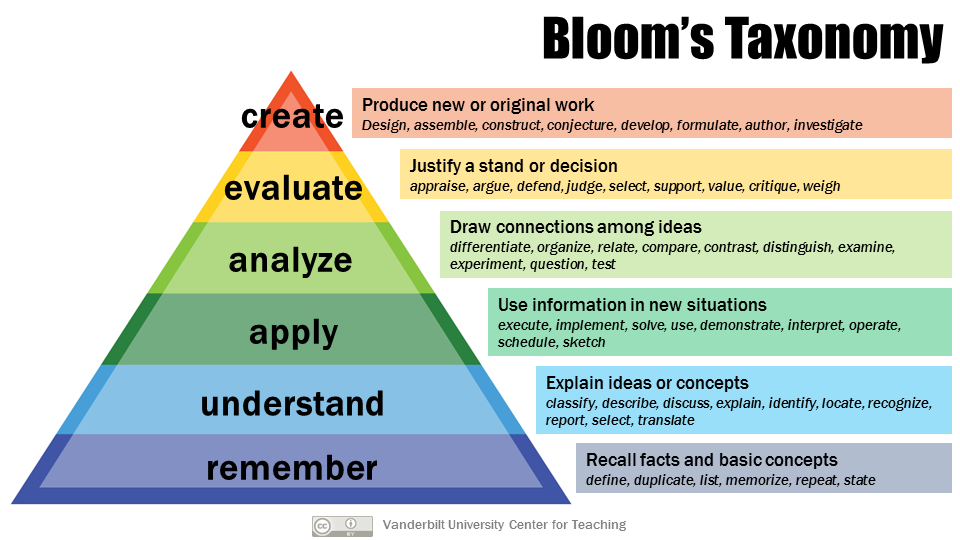Writing Outcomes and Objectives
The Structure of a Learning Outcome or Objective
Outcomes and objectives typically follow this structure or three-part formula. See the outcome and objective formula below, followed by examples of the three-part formula.
Outcomes and objectives are often based on Bloom’s taxonomy, which help determine levels of learning using action words or verbs to describe cognitive processes. There are several visual guides and resources to assist you in selecting appropriate verbs for different types and levels of learning. Figure 1 below illustrates the hierarchy of lower to higher order thinking skills. The following section of this guide will provide more in-depth information about Bloom’s Taxonomy framework.
Figure 1. “Bloom’s Taxonomy” by Center for Teaching Vanderbilt University. Licensed under CC BY. [Image Description]
Bloom’s Taxonomy Visual Guides
There are several visual tools (wheels and charts) that assemble and cluster action verb/objectives, descriptions of potential learning activities, and the level of learning. These tools may be useful to develop learning objectives.
- Bloom’s Verbs and Matching Assessment Types.
- A guide for using Bloom’s Taxonomy in blended learning
- Learning Outcomes – Guide to Teaching with Technology (uregina.ca)
Longer-term Course Design Considerations
Since the revision of course outcomes and objectives require formal approval, a useful design approach is to consider how to minimize the need to make frequent changes. As you write course outcomes and objectives, consider flexible and timeless strategies to ensure that the course expectations offer flexibility around instructional approaches and prevent the course from getting dated too quickly.
Revision of Course outcomes and Objectives
Any changes to outcomes or objectives should be undertaken with the permission of your Associate Dean. Changes to course outlines that constitute less than 30 percent of the course must be approved by the Associate Dean. Any changes that constitute more than 30 percent of the course must go through a more complex approval process. Please see the Program and Curriculum Change Process.
Flexibility
Since outcomes and objectives inform how a course is taught, when an instructor builds in some flexibility it also becomes good professional practice to account for different teaching approaches as the written curriculum most likely will be shared with other course instructors. This means the focus of outcome and objective construction is on how the skills and knowledge are acquired rather than identifying the specific evaluative methods or tools to assess learning.
For example,
Instead of…
Try…
In this example, the more flexible objective focuses on the reflective practice skills that the students develop instead of the format (journal), mode of expression (written) with a specified schedule and frequency (weekly). Ultimately, the instructor might offer students multiple forms of expression — a video diary, e-portfolio, reflective podcast, etc. — to provide a more inclusive approach with multiple methods for articulating reflective learning.
Timelessness
Course outcomes and objectives can become dated quickly, especially in subjects where the field or industry undergo progressive change. Avoiding references to specific approaches, tools, software, or other elements that evolve or change, will ensure that instructors can adapt their courses as needed while still addressing the central knowledge and skills.
Instead of…
Try…
In this example, specifying the social media management platform (Hootsuite) may become outdated or not reflect current industry practices. Referencing ‘industry standard tools’ also sends a signal to your learners that the tools you employ in your course are both relevant and current.

